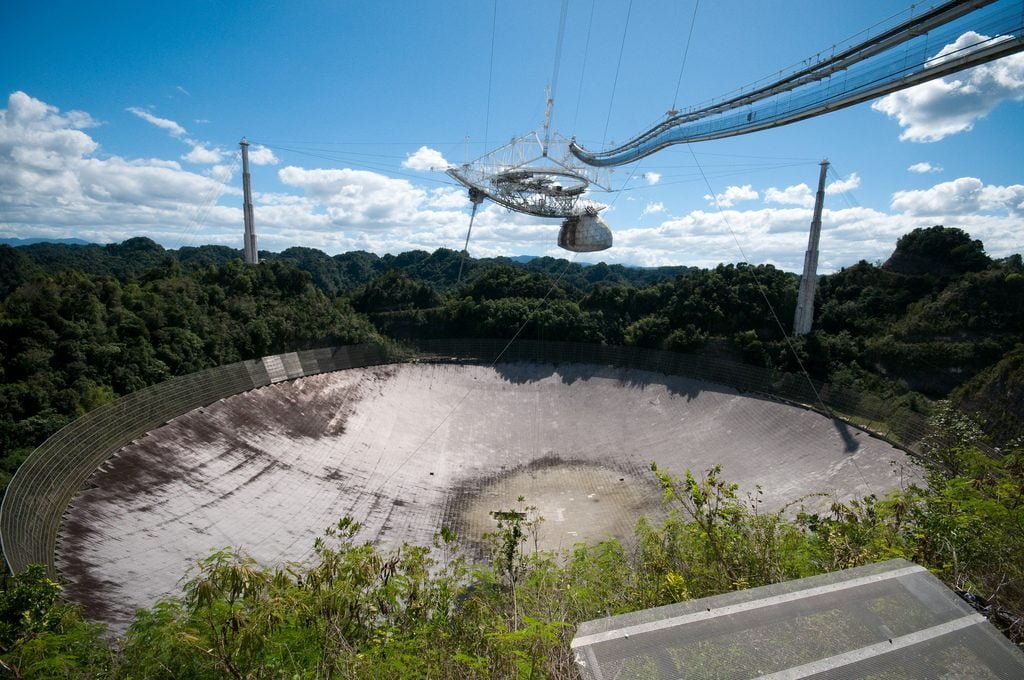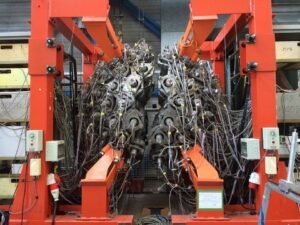
A radio telescope is used to pick up radio waves instead of light waves radio telescopes have a big dish to collect and focus data at the centre of the dish it has an antenna to pick up radio signals. Radio telescope dishes are very big around 100m diameter because the wavelength of radio waves is much longer than light waves.
Some radio telescope uses a collection of small linked dishes instead of one big dish. With the help of radio telescope big discoveries like pulsar and background radiation from the big bang could possible. Radio telescope collects radio waves coming from the space most radio waves can travel through the air so these telescopes are build on the ground but there are lots of the radio waves travelling around the earth carrying tv signals radio signals and phone calls these can all interfere with the faints radio waves from space radio telescopes works like reflecting telescopes but instead of using a mirror radio waves are collected by a metal dish they look like huge satellite tv aerials most dishes can turn to a point at target anywhere in the sky and can track targets moving across the sky.
What does Radio telescope use for
Some scientist uses radio telescope to listen out for message from aliens on another planet or in other galaxies but they have not found any yet we cannot see radio waves but astronomer turn signal into images we can see. The images from a single radio telescope dish are not very detailed but several radio telescopes linked together can reveal finer details (currently blackhole image is an example). The very large array in New Mexico USA has 27 separate dish antennas in a y shape all working together as thought it was one huge dish 36 km across.
Radio waves come from cool gas between the stars. This gas is not hot enough to glow so it cannot be seen by ordinary telescopes. Radio telescopes have mapped clouds of gas showing in the shape of the milky way galaxy. They have also discovered what seems to be a massive black hole at its center. Radio waves reveal massive jets of gas shooting out from distant galaxies.
The jets are thrown out by a giant’s black hole in the middle of some galaxies which are gobbling up stars and gas around them. The discovery of pulsar could be possible by with the help of radio telescopes the first spinning neutron star called a pulsar was discovered in 1967 by British astronomer Jocelyn bell Burnell this star spin 30 time in a second. Astronomers are planning for a radio telescope to be built in Australia or south Africa. It is called the square kilometer array and will have at least 3000 separate radio telescope it should start working in 2020 Alma (Atacama large millimeter array) Alma is a powerful new radio telescope built up in the Atacama Desert in Chile.
First radio telescope

In 1937, Gote Reber built a telescope with a dish in the shape of a parabola — just like the mirrors of other reflecting telescopes. The 31-foot (9-meter) iron dish could be turned north and south, but not east or west, so Reber had to wait for the Earth’s rotation to bring the object he wanted to observe into the view of the telescope. The dish directed the radio waves toward a receiver.
Radio waves have their advantages. Like visible light, they pass through Earth’s atmosphere without being absorbed, but they are not distorted by the atmosphere, as visible light can be. In addition, there isn’t much radio-wave radiation in nature to interfere with observing the radio-wave radiation from the sky. However, astronomers have to watch out for man-made radio signals, as Reber discovered.
Largest radio telescope in the world

The world biggest single dish radio telescope was built in Puerto reco in the Caribbean about 40 years ago. It is 305 m across,167 feet deep, and covers an area of about twenty acres. so it would take you more than 10 minutes to walk around the edge of its.
World most powerful radio telescope
The Atacama Large Millimeter/submillimeter Array (ALMA) is the world’s most powerful observatory for studying the universe at the long-wavelength millimeter and submillimeter range of light. It’s designed to spot some of the most distant, ancient galaxies ever seen, and to probe the areas around young stars for planets in the process of forming.
Radio telescope at india
The Giant Metrewave Radio Telescope (GMRT), located near Pune (Narayangaon) in India, is an array of thirty fully steerable parabolic radio telescopes of 45 metre diameter, observing at metre wavelengths. It is operated by the National Centre for Radio Astrophysics, a part of the Tata Institute of Fundamental Research, Mumbai. At the time it was built, it was the world’s largest interferometric array offering a baseline of up to 25 kilometres (16 mi).
The GMRT is located about 80 km north of Pune at Khodad. A nearby town is Narayangaon which is around 9 km from the telescope site. The office of NCRA is located in the Savitribai Phule Pune University campus.
One of the aims for the telescope during its development was to search for the highly redshifted 21-cm line radiation from primordial neutral hydrogen clouds in order to determine the epoch of galaxy formation in the universe.
Astronomers from all over the world regularly use this telescope to observe many different astronomical objects such as HII regions, galaxies, pulsars, supernovae, and Sun and solar winds.



